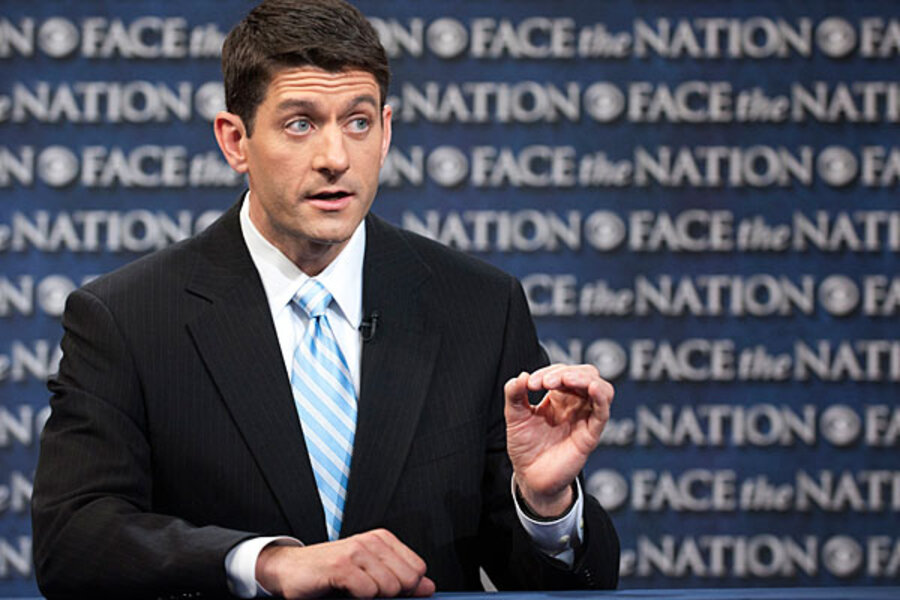The Paul Ryan 2012 budget: What he learned in 2011
Loading...
| Washington
Paul Ryan’s budget, 2012 edition, looks substantially like its 2011 predecessor. But it doesn’t sound the same.
Gone are the snippets from political philosopher John Locke and the venerated words of various saints of American political history — Thomas Jefferson, Ronald Reagan, and Theodore Roosevelt among them.
In short, Ryan 2011 sounded like a graduate thesis on statistical steroids. Ryan 2012 is like an 80-page campaign commercial.
The distinctions help map out where the country was in 2011, how Republicans have responded to the initial Ryan budget, and how they see the budget in the context of the 2012 campaign.
Back in 2011, Republicans had just surged back into the House of Representatives on a wave of back-to-the-roots conservative groundswell. Under the broad heading of the "Tea Party," the movement that gave Paul Ryan the gavel of the House Budget Committee, was going to get its out-of-control government, Obamacare, the stimulus, bailouts of the automotive and financial industries under control.
At that moment, Ryan wrote a budget that sounded like it could be delivered as the keynote for the Jim DeMint Prize in Economic Freedom. Ryan tied the Declaration of Independence (publication date: 1776) with Adam Smith’s “The Wealth of Nations” (publication date: 1776), noting a confluence of moral and economic sentiments.
It made a brisk walk from there through Locke, George Washington, Alexis de Tocqueville and Alexandr Solzhenitsyn, who give us one general thought: Commerce is good, America is great because it recognizes this, and American commerce is part and parcel of the nation’s moral underpinnings. From there, the 2011 budget propositions grew.
How did that 2011 budget go over, politically? As POLITICO’s Jake Sherman writes, not so well: “The Paul Ryan budget was a political disaster last year for Republicans.”
They got hammered by Democrats who, in one memorable campaign ad, showed a Paul Ryan look alike literally pushing grandma (Medicare) off a cliff. This year, Politico's Sherman continues, Republicans got a lesson in political messaging before the budget saw the light of day: Say things like “bipartisan” and claim to “fix” Medicare to “keep it from going bankrupt.”
Reading the 2012 budget, this lesson was well-heeded.
The first page of the 2012 Ryan budget is a chart titled “A Contrast in Visions,” stacking up Ryan’s budget against President Obama’s. While James Madison and Winston Churchill make cameos in the introduction, the most frequently-footnoted non-technical source in the document may very well be Barack Obama, as Ryan continually contrasts his views with that of the president.
Republicans, Ryan’s 2012 budget says, aren’t flying off the tea party handle any longer. This is a budget about the president as much as it is about the GOP, echoing the theme that many Republican elder statesmen have noted over the past several months: Republicans may not be fired up by their presidential choices but they’re definitely enthusiastic to beat Mr. Obama.
But for all the changes, one thing has stayed the same: Ryan’s insistence that we’ve reached a historic moment to deal with America’s financial challenges.
“It is rare in American politics to arrive at a moment in which the debate revolves around the fundamental nature of American democracy and the social contract. But that is where we are,” Ryan wrote in Tuesday’s Wall Street Journal. “And no two documents illustrate this choice of two futures better than the president’s budget and the one put forward by House Republicans.”
Of course, that rare moment Ryan describes also happened in 2011.
As the introduction to Ryan’s first budget puts it, “[r]arely before have the alternatives facing America been so starkly defined.”
Indeed. Here’s to a historical 2013, too — and perhaps, as Thomas Jefferson put it, “a wise and frugal government.”





